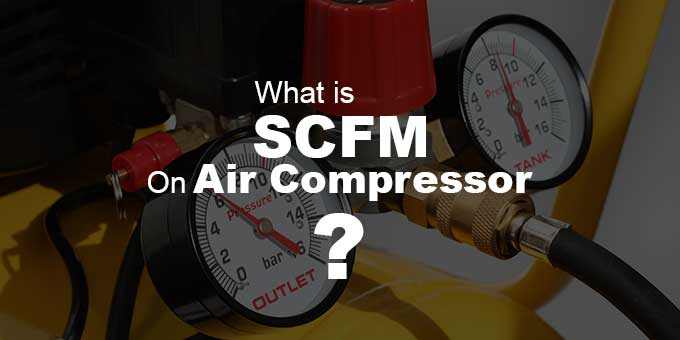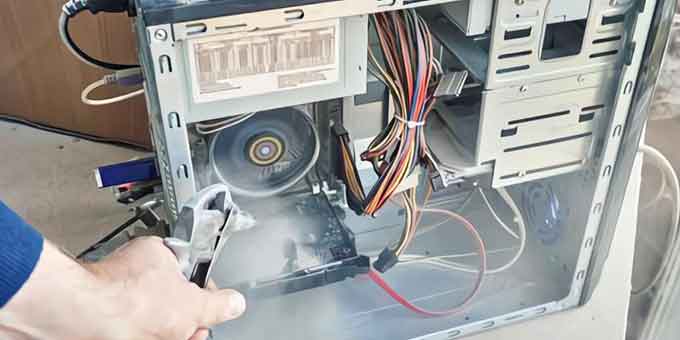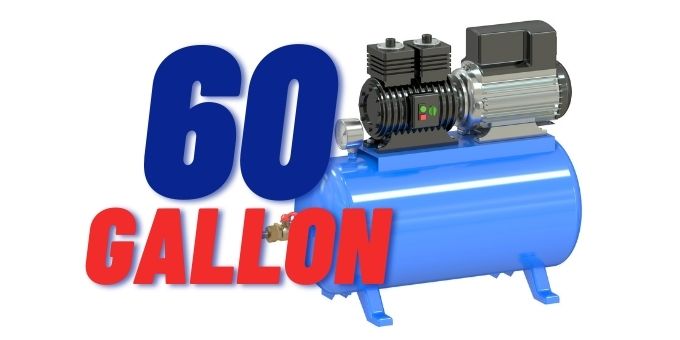The first thing you need to know is the definition of SCFM. It’s the standard cubic feet measurement, which tells you how much air a compressor can process.
Each air compressor is rated for a specific SCFM, so it’s one of the most essential terms you must understand. Once you know what it stands for, you may choose air tools that fit your requirements.
The Real Meaning of SCFM
Although understanding what SCFM means is important, the crucial aspect about it is knowing what it represents for you.
Many people believe that knowing what SCFM stands for is enough. However, you should keep in mind that the cubic feet per minute are a vital measurement to know the capabilities of your air compressor.
If you know the SCFM of your air compressor, you can determine what they’re capable of. Therefore, you might understand their maintenance needs, why they work the way they do, and so on.
Why Does SCFM Matter When Talking about Air Compressors?
The term SCFM describes the standard cubic feet per minute. Logically, it considers several standards to which everyone can compare their air compressors, and the organizations in charge of determining the numbers are the American Society of Mechanical Engineers (ASME) and the Compressed Air and Gas Institute (CAGI).
Both organizations have specified standard conditions, for example, 14.7 PSI, 36 percent relative humidity at sea level, and 68 degrees Fahrenheit.
In many cases, you might have a challenging time trying to understand all the numbers. Overall, there are a few terms to keep in mind when talking about pressurized air and cubic feet per minute, for instance, mass flow rate.
When you measure SCFM, you’re considering mass flow rate, which is how much substance or particles pass through actual cubic feet during a specific time unit.
Even though you might believe the previously mentioned term is not important to understand how compressed air works, it’s actually essential. Comprehending the definition is crucial because it’s the way you determine whether your air compressor is powerful or not.
In other words, the standard cubic feet per minute let you compare one air tool to another one. You can understand their power, and determine if the pressurized air they offer you is enough to fit your needs.
What Is CFM?
As was mentioned before, to understand and compare air compressors, you have to know the standard cubic feet per minute measurements. However, there’s also CFM, which simply means ‘cubic feet per minute.’
In this case, it’s a unit that helps you measure the air that an air compressor discharges over time. Each compressor’s number is different, which is why understanding the term is so important.
If you have an air compressor in your home workshop or in a plant, you might want to know the actual cubic feet of air it can give you. Since each air tool is unique, the only way to know this is to comprehend how much air volume you get.
Your air compressor has a discharge port that releases compressed air flow at a specific rate. If you check the volume flow rate, you might be able to determine if it’s enough to power all your air tools or not.
CFM values are essential to understand air volume and if your air compressor fits your needs or not. There’s no other way to know how much pressure the machine can give you, or if you might need more air than planned.
Difference Between CFM and Standard Cubic Feet per Minute
When you’re evaluating all your options to buy the right air compressor, you might want to assess CFM values and SCFM rating, which are both good factors to determine the machine’s internal capacity.
On the one hand, SCFM is essential to understand how your air compressor works in comparison to a standard volume flow rate. Thus, you can use it to identify if the air compressor’s tank is strong enough for what you need to power a specific air tool.
Nonetheless, CFM is crucial as well since it’s a better way to comprehend the internal capacity of air compressors. Consequently, it’s a better way to determine if you have enough air on a general level.
You can calculate CFM values if you want, but it can be a slightly confusing process because the air passes differently. Instead of comparing it to the standard measurements defined by the organizations, you would be considering the actual functioning of your air compressor, which is why people call the result the ‘ASCFM rating.’
CFM and SCFM in Air Compressor Evaluation
When you get an air compressor, you have to consider how much newly pressurized air it can give you per minute. To measure tools, on the other hand, you need to keep in mind the amount of air they need to function. As a consequence, both aspects go hand in hand, which is why the SCFM rating is so important.
Getting an air tool means you might have two different factors to deal with: SCFM and psi. The latter refers to the pounds per square inch of air pressure.
Fortunately, manufacturers always include SCFM and CFM ratings of their air compressors. If you examine your air tools, you might also find the square pounds per square inch of air pressure and the SCFM, so you don’t need to do much to have the information at hand.
Even though you may not have to calculate SCFM when you buy an air compressor, things are different with CFM. In this case, discharge rates might be different from what you think, so if you want an accurate number, you need to calculate the CFM rating.
The most important thing to keep in mind is that you must ensure that your air compressor gives you the CFM you need and the pressure all the tools are demanding from you.
Is CFM Lower than SCFM?
Evaluating a compressor tank may be a challenging task if you’ve never done it before, and you might feel confused if you find that your CFM rating is lower than the SCFM value. However, it’s completely normal.
You are getting the CFM value after the air is pressurized, which means it’s smaller in volume. Therefore, when measuring gas, don’t worry about finding discrepancies between SCFM and CFM.
How Much You May Need for Air Tools
Once you understand what CFM, SCFM, psi ratings, and similar measurements mean for air compressors, you might wonder how to use the information for your benefit. In the end, you probably want to buy a product with the best air tank and volume flow rate.
When you’re in a factory and need pneumatic tools, you probably need a strong compressor pump to handle all the equipment. Consequently, you must compare the total of what the air compressor is offering you with regards to what you need.
Generally speaking, your air compressors should at least be 150 percent more powerful than the CFM you require. Nonetheless, things are different when you’re getting a compressor for your home.
Unlike industrial use, home use does not require you to have so much power in the compressor tank. Even so, you still need to compare what the machine offers you with what you need and ensure that you include the amount of time you’re going to use it. You don’t want to exceed the compressor’s duty cycle, so making the right calculations is vital.
It may interest you: How to increase CFM on your air compressor
Pressure and Volumetric Flow Rate for an Air Compressor System
Atmospheric pressure and volumetric flow rate are two more concepts you should keep in mind if you’re considering industrial or portable compressors.
The volumetric flow rate refers to the specific amount of fluid passing through the air compressor at any precise moment. On the other hand, atmospheric pressure is the amount of pressure your unit is getting per inch.
To understand the duty cycle of your air compressor, you need to keep in mind both the pressure and the volumetric rate of the machine. While the first number lets you know if your operation can be successful or not, the second one indicates if your tools can get a certain air volume at any given time.
Furthermore, the volumetric rate can change depending on different factors, for example, the number of attachments your compressor has, its setup, possible leaks, and the length of the pipe.
One last thing you should keep in mind about pressure is that it has an inverse relationship with CFM. Consequently, if you have more pressure, it means the CFM is lower. If you understand all the details of this process, you can determine the size of the compressor you need.
Keynote Takeaways
Professionals calculate SCFM values to identify specific standards, which allows you, along with the CFM ratings, to determine the kind and size of air compressor you need. Powering different air tools is possible, but you need certain pressure to achieve it.
Now that you understand how much SCFM is important to comprehend the vast majority of factors related to buying a compressor, you can evaluate your options, and determine the type of machine you need.









